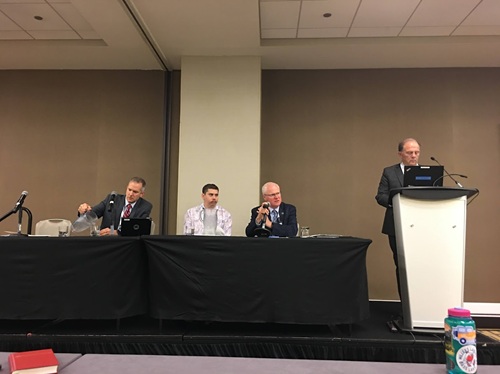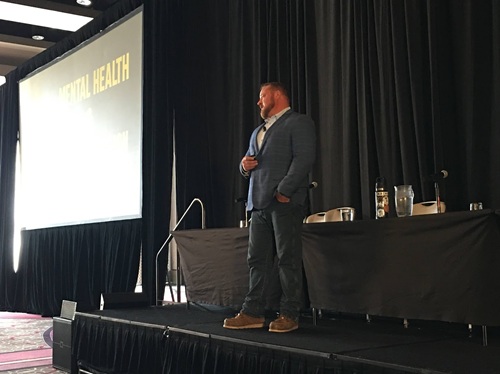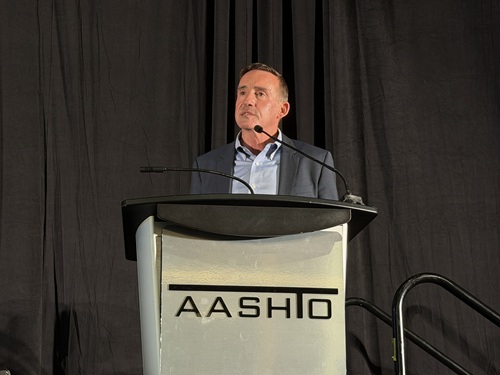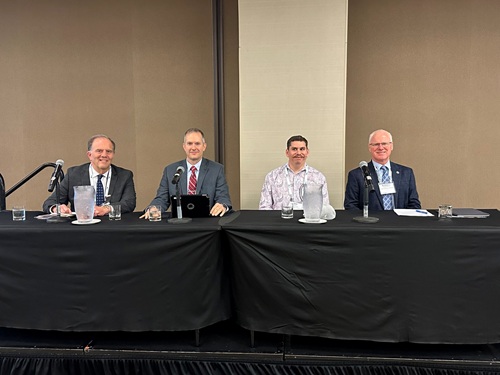A panel discussion held at the American Association of State Highway and Transportation Officials 2025 Safety Summit and Peer Exchange in New Orleans discussed the successes and ongoing challenges of deploying vehicle-to-everything or V2X technologies and connected and automated vehicles or CAVs on roadways across the country.
[Above photo by AASHTO]
Russell McMurry, commissioner of the Georgia Department of Transportation and AASHTO vice president, moderated a panel comprised of Ben McCulloch, strategic data scientist for the Texas Department of Transportation; Wes Musgrove, director of the Systems Operations Division at the Iowa Department of Transportation; and Nicholas Ramfos, director of the National Operations Center of Excellence or NOCoE.
McMurry pointed to Georgia DOT’s partnership with The Ray – a public-private-philanthropic partnership formed in 2019 – to foster a digital testing environment focused on critical interstate use cases, such as crash and weather warnings, for stakeholder engagement and education.

That work encompasses an 18-mile corridor of rural interstate known as The Ray Highway, which features a “connected vehicle ecosystem” with six dual-mode and dual-active roadside radios as well as a number of cellular V2X or C-V2X equipped vehicles owned by the Georgia DOT that are connected to Panasonic’s CIRRUS cloud-based data management platform.
“Public-private partnerships make this happen – improving connectivity so vehicles and infrastructure can learn from each other,” McMurry said. “It is about creating ‘living laboratories’ to bring in transportation, safety, and security technologies together.”
He added that investments in connected technology will pay dividends when car makers begin installing V2X chip sets in their vehicles. “The technology is real, but I also think the journey never ends,” McMurry noted.
TxDOT’s McCulloch said his role in the V2X and CAV space is helping people make good decisions with data – both internally within state DOTs and externally as well.
“Using connected vehicle data can give you a 365, 24/7 look at vehicle speeds and behavior across your entire road network in real time,” he explained. “But there is a big need for cross-state data integration. TxDOT has a lot of systems, they play well together, but not with those systems outside of our state. We need to make sure my infrastructure speaks the same language as yours. That takes a lot of conversation and meetings. The way we collect the data doesn’t matter – it is how the data is communicated. We also need more tools and platforms to help us synthesize this data into something useful.”
Iowa DOT’s Musgrove echoed McCulloch’s comments, pointing to his agency’s work as part of the I-80 Corridor Coalition, which seeks to improve freight movements on this highway across eight states. “Data standardization is so important, especially when we take such programs national,” he said. “Not only are we working on ways to leverage all of this data, but we are also looking to define the exact universe of data we need to collect for such programs.”
Ramfos of NOCoE – a partnership of the American Association of State Highway and Transportation Officials, the Institute for Transportation Engineers, and the Intelligent Transportation Society of America, with support from the Federal Highway Administration – added that other questions need to be asked, too, such as what happens when systems crash and how data from connected vehicles gets measured.
“To really measure the benefits of V2X, we really need a lot of vehicles equipped with V2X – we need to get a lot of data to generate statistical significance,” he explained. “We also need a format to follow, for if you want to have a truly single system, you need a single uniform format to follow. How will that work? It starts by streamlining data procurement contracts – making that simpler and faster.”
 Top Stories
Top Stories
Safety Summit Addresses Employee Mental Health
November 7, 2025 Top Stories
Top Stories

